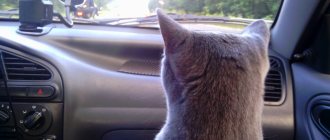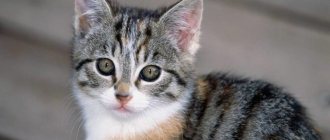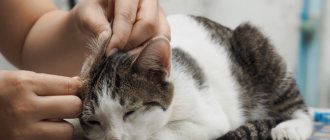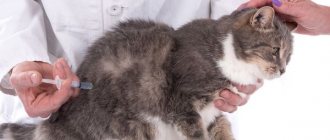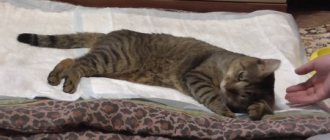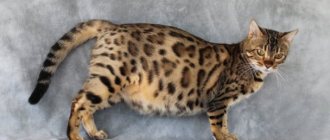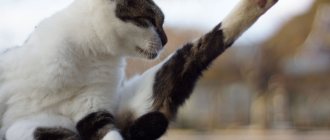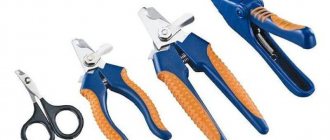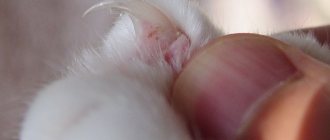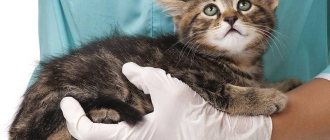A cat's manicure not only helps the animal successfully catch prey and protect it from potential enemies, but also helps it climb trees and leave special marks for its relatives. Often, an animal’s claw grows into its paw pad, which causes inconvenience and threatens the development of a serious inflammatory process.
The owner should pay close attention to the problem and provide timely assistance to the pet. In advanced cases, the cat can only be restored to health through surgery.
Causes of ingrown claws
Pets that spend a lot of time outside wear down their claws naturally. On the front paws - on the bark of trees, on the hind paws - on the asphalt when walking. Domestic cats that do not leave the apartment love to sharpen their nails on furniture upholstery, wooden surfaces or walls.
With normal growth, the nail has a moderate bend and does not touch the paw pad with its sharp end. The cause of ingrowth is often the following factors:
- the cat's passivity, its inactivity;
- inability to properly grind off an overgrown nail plate;
- genetic feature;
- deficiency of micro- and macroelements in the body;
- injuries received from a fall or during physical activity.
With normal growth, the claw has a moderate bend.
Veterinary studies have shown that the risk of developing pathology is much higher in adult cats than in young cats.
Symptoms and possible complications
It is quite easy to notice an ingrown claw in your pet. The problem is indicated by atypical behavior of the pet:
- Since the sharp tip of the nail injures the soft tissues, the animal develops noticeable lameness. Painful sensations do not allow the cat to fully step on the damaged paw, and therefore he begins to limp.
- The pet pays a lot of attention to the sore limb. He constantly licks his foot and tries to bite off the offending nail with his teeth.
- The pet becomes inactive, lies down more, and does not show interest in regular games.
If you notice uncharacteristic behavior, you need to carefully examine your pet's paws. An ingrown nail is usually longer than the rest, strongly curved, and often stuck into soft tissue. When a mechanical impact is applied to the pad, the cat becomes aggressive, hisses, bites, and tries to escape from the hands.
Pet constantly licks foot
If the problem is not corrected, it can adversely affect the quality of life of the furbaby:
- he will have a constant feeling of discomfort;
- pain or discomfort;
- habitual activity and mobility will be forced to decrease;
- lameness and unsteadiness of step will appear.
When an infection gets into the wound, inflammation often begins. If no action is taken, an abscess may develop, which can lead to sepsis.
Treatment at home
Owners who have never encountered the problem of an ingrown claw often make the same mistake - they try to pull it out manually. You shouldn't do this. Veterinarians advise not to rush, but to carry out the removal procedure, following all the rules:
- Disinfect nail clippers with alcohol;
- secure the cat so that it does not escape and accidentally bite your hand;
- thoroughly wipe the damaged pad with an antiseptic;
- carefully trim the nail, trying not to damage the part where the capillaries begin;
- if the sharp tip has grown into the soft tissue, carefully remove it with tweezers (you need to pull the claw out of the pad with a sharp, quick movement in the opposite direction of growth);
- treat the wound with hydrogen peroxide;
- apply a bandage with antibacterial ointment and stick it with a bandage;
- Carefully sharpen the trimmed nail with a nail file, smoothing out any sharp spots.
You can pull out the claw yourself only in the absence of an inflammatory process. If the pad is swollen, reddened, and hot to the touch, it is better to take your pet fluffy to a veterinary clinic so that he can receive medical care.
You can pull out a claw yourself only if there is no inflammation.
What should the owner do?
Sooner or later, the owner will notice that the pet is limping or frequently licking its paw. He will examine it and find a claw or several embedded in the pad. There will be redness and swelling around the injured soft tissue.
The owner will want to feel that place, but the pet will experience pain, fear and will struggle, hiss, and try to bite. Even if the owner has pliers that can be used to cut off the ingrown tip of the claw, he cannot cope alone. It happens that someone in the household holds the cat and the owner manages it himself. If he cannot do this, then the pet needs to be placed in a carrier and taken to an appointment with a veterinarian. He will definitely help.
How can an owner help a pet?
When the owner notices that the claw has grown into the pad, he will be able to help on his own only when the soft tissues around are not inflamed. An ingrown claw is cut off with pliers designed for trimming animal claws. Guillotine cutters won't help here.
The tool must be disinfected with alcohol or held over a fire. Wait until it cools down and carefully trim the claw, being careful not to touch its capillary and soft tissue of the pad. The ingrown piece of the claw is grabbed with tweezers or the same nippers and pulled in the opposite direction from the direction of ingrowth.
Now the paw pad is treated with an antiseptic, for example, peroxide, Chlorhexidine or Furacilin, or something else. The same claw needs to be trimmed as short as possible
It is important not to touch the vessel
What to do if your cat has ingrown claws:
If the area around the ingrown claw is red and swollen, you should not cut off or pull out the claw yourself. You need to take your pet to an appointment with a veterinarian and he will do it professionally. It will remove all pus from the wound and thoroughly disinfect it to avoid suppuration of the pad.
Help at the veterinary clinic
The extent of surgical intervention is determined by the doctor after a thorough examination of the animal. He evaluates the depth of the ingrowth, the degree of inflammation, and the general condition of the cat. If there are no complications, the doctor removes the problematic nail with a special tool, having previously treated the pad with an antiseptic. If inflammatory processes have already begun to develop, the operation is performed under local anesthetic. During the procedure, the veterinarian opens the abscess to remove the claw, pus, and clean out the wound. But very advanced cases require general anesthesia.
After the manipulations, the doctor applies a sterile bandage with antibacterial ointment to the furry patient. To neutralize the inflammatory process, he prescribes a course of antibiotics, and for a speedy recovery, he prescribes mineral and vitamin complex preparations. If the animal is too weakened, it adds drugs that strengthen the immune system to the treatment regimen.
During the rehabilitation of the furry, it is necessary to regularly change the bandages. At the same time, you should not glue them with adhesive tape, so as not to further injure the surrounding tissues. If the cause of an ingrown toenail is genetic, the problem is likely to recur. During a relapse, it is best not to treat the animal yourself, but to contact a veterinarian for a second course of treatment.
After the manipulations, the doctor applies a sterile bandage to the cat.
A cat has an ingrown toenail: how to help your beloved furry friend?
A cat's manicure not only helps the animal successfully catch prey and protect it from potential enemies, but also helps it climb trees and leave special marks for its relatives. Often, an animal’s claw grows into its paw pad, which causes inconvenience and threatens the development of a serious inflammatory process.
The owner should pay close attention to the problem and provide timely assistance to the pet. In advanced cases, the cat can only be restored to health through surgery.
Read in this article
Prevention of ingrown claws
We recommend this article:
How to properly trim the claws of a kitten and an adult cat
No pet is immune from re-ingrowing nails, no matter how old they are. You can reduce the risk of a problem occurring by:
- install a device for grinding nails;
- give your furry manicure regularly;
- If the claws are irregularly shaped or have growth problems, have them trimmed by a specialist;
- avoid traumatic situations where the cat may damage its paws;
- Closely monitor the health and behavior of your pet, especially an older one.
When cutting nails, you should not forget about the fifth finger, which is located on the forelimbs just above the main four. This is where the problem of ingrowth most often arises.
To prevent manicure from causing severe stress for your pet, it is best to accustom him to the procedure from an early age. The cutters must be in good working order, well sharpened, and disinfected. Otherwise, there is a risk of delamination of the nail plate. The trimming manipulation itself consists of several steps:
- pre-treat hands and manicure tools with antiseptic;
- gentle stroking calms the cat;
- place it comfortably on your hands, fixing the position;
- taking the limb, lightly press on the foot so that the claws are clearly visible;
- the nippers are placed perpendicular to the nail plate, just above the area where the blood capillaries begin;
- cut the nail with a sharp, quick movement;
- Use a nail file to carefully smooth out the sharp edges.
If blood vessels were damaged during pruning, which led to bleeding, the damaged area should be treated with an antiseptic and a swab with hydrogen peroxide should be applied.
Taking the limb, lightly press on the foot. Trim the nail with a sharp, quick movement. Carefully smooth out the sharp edges with a file.
We recommend this article:
How is declawing done in cats and is it worth it?
Trimming cat claws is a mandatory pet care procedure, which is the main method of preventing ingrown nail plates. By following all the rules, a manicure can be done quite quickly without causing discomfort to your pet.
Recommended Posts
How is declawing done in cats and is it worth it?
How to properly trim the claws of a kitten and an adult cat
Features of cutting nails for a toy terrier
How to properly stop a cat from scratching furniture and wallpaper in the apartment
How to properly use anti-scratch products for cats
How to help your toy terrier during pregnancy and childbirth
Pododermatitis
Pododermatitis or inflammation of the soft tissues of the paws is the most common disease in cats and dogs. During pododermatitis, the animal has difficulty taking normal steps, and any movement leads to severe discomfort and pain. Because of this, cats and kittens develop nervousness and aggressive behavior.
shutterstock
It is difficult to identify this diagnosis in the first stages; they are impossible for the average person to notice. Therefore, the disease starts, and the consequences become irreversible.
Causes of the disease:
- influence of pathogenic bacteria. When a cat has injured its paw, the variation in bacteria entering the body increases significantly. Incorrect disinfecting manipulations cause fungal manifestations in the tissues of the paws. It is difficult to detect and even more difficult to treat. Most often, the result is a chronic fungal disease.
- hypothermia. During the cold period, there is a risk of severe hypothermia, and therefore it is not recommended to let cats go for a walk during this period. The streets are filled with chemicals, and they can irritate the delicate tissue of the paws, which can cause necrosis in felines. Because of this, the pads are completely destroyed, and as a result - lameness.
- exposure to allergens. Allergens can cause dermatitis; indoor cats are more susceptible to this. A weakened animal's immune system may not cope well with this disease.
- consequences of autoimmune diseases. Most often, plasmacytic pododermatitis appears after autoimmune diseases. Due to the late detection and treatment of the disease, it is necessary to give the cat special medications throughout its life to keep the disease under control.
Symptoms and diagnosis of pododermatitis
Every second observation will help to identify any disease in the early stages, and contacting a specialist in the early stages will help to avoid negative consequences and quickly cure feline diseases in a cat.
In the initial stages of paw pad problems, there are various symptoms:
- the cat spends a lot of time on paw hygiene
- the pads are very soft
- From time to time blood is visible on the surface of the pads
Ignoring any of the signs can contribute to the development of severe necrosis, which carries with it a high likelihood of sepsis. In this case, veterinarians cannot guarantee a high survival rate for the cat, and most methods of treating the disease are ineffective.
shutterstock

